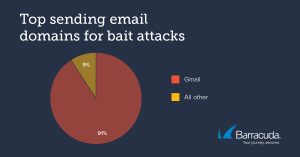
Bait attacks, also known as reconnaissance attacks, are usually emails with very short or empty content. The aim is to check the victim's email accounts. Barracuda Networks' Bait Attack Tips.
In view of the increasing professionalization of cyber criminals, companies must be able to ward off all kinds of attacks. However, with extremely elaborate attacks, there is a risk that hackers will succeed in infiltrating the network and moving there unnoticed. In order to use such an emergency for the clarification of the opposite side, it is well known that there are now technologies that are stored in web applications or endpoints using bait and can only be found by actors with malicious intentions. So much for the good news. Conversely, cyber criminals are also increasingly using bait to gather information that they can use to plan future targeted phishing attacks.
Prepare for phishing attacks
The decoy attacks, also known as reconnaissance attacks, are usually emails with very short or empty content. The aim is to either verify the existence of the victim's email account by not returning "undeliverable" emails, or to engage the victim in a conversation that may maliciously end with money transfers or leaked login credentials.
In order to be able to act undetected, the criminals usually use new e-mail accounts with free providers such as Gmail, Yahoo or Hotmail to send their attacks. They pay attention to a low transmission volume in order to avoid mass- or anomaly-based abnormalities.
Many companies are hit by bait attacks unnoticed

Criminals use new e-mail accounts with free providers such as Gmail to send their attacks (Image: Barracuda).
The number of bait attacks is still low overall, but not unusual or less dangerous: Barracuda analysts found that last September, slightly more than 35 percent of the 10.500 companies analyzed were affected by at least one bait attack, with an average of three different mailboxes each Companies received one of these messages.
How do bait attacks work?
It is in the nature of things that bait attacks precede a targeted phishing attack. Barracuda's security analysts conducted an experiment by responding to one of the sent baits that was in an employee's mailbox.
The original attack — dated August 10 — was an email with the subject line “HI” followed by a blank text field. On August 15, the employee replied with the email content: "Hello, how can I help you?". 48 hours later, a targeted phishing attack was launched on the employee's email account. The original email was designed to verify the existence of the mailbox and the victim's willingness to reply to email messages.
How can you protect yourself from bait attacks?
AI can detect and block bait attacks. Conventional filter technologies are largely helpless when it comes to repelling bait attacks. They do not carry any malicious payload and are usually from reputable email providers. An AI-based defense helps much better. It uses data obtained from various sources such as communication graphs, reputation systems and network-level analyzes to protect potential victims from such attacks.
Training to detect and report bait attacks. Training courses help to make employees aware of how to recognize bait attacks and not to respond to them, but to report them to the IT and security teams. Examples of bait attacks should be part of safety awareness training and simulation campaigns.
AI techniques are useful for detection
Bait attacks cannot go into users' inboxes. If decoy attacks are detected, it is important to remove them from users' inboxes as soon as possible before they open or reply to the message.
Automated incident response can help identify and eliminate decoy attacks within minutes to prevent further spread of the attack or make the company a future target.
More at Barracuda.com
Via Barracuda Networks Striving to make the world a safer place, Barracuda believes that every business should have access to cloud-enabled, enterprise-wide security solutions that are easy to purchase, implement and use. Barracuda protects email, networks, data and applications with innovative solutions that grow and adapt as the customer journey progresses. More than 150.000 companies worldwide trust Barracuda to help them focus on growing their business. For more information, visit www.barracuda.com.
